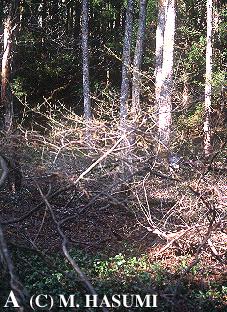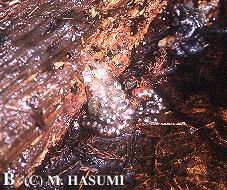

 |
 |
(A) Part of this wetland. A seeming adult male of Hynobius kimurae, and 2 spent females and 1 subadult of H. hidamontanus were found above ground under logs; the former, near the opening of a subterranean stream. A torrent located above this opening was utilized for oviposition of H. kimurae.
(B) Nine pairs of egg sacs of H. hidamontanus, the adhesive tips of which were attached to the under side of a decaying log in one branched stream (this was photographed keeping the under side of the log up). At the time of examination, there were 3 breeding males, 3 overwintering larvae, and 41 pairs of egg sacs with many of the stages of morula-blastula, under decaying logs and twigs or among decaying leaves in the two branched streams. The vegetal pole of embryos in the egg sacs of H. hidamontanus colored mint green, but not cream yellow generally seen in amphibian embryos. This coloration was the same as that of embryos in Hynobius nigrescens (Hasumi, 1996).
Accompanied Research Collaborators (alphabetical order every organization): Yoko Arai, Yoko Iwata, Kazuko Uenami, and Yoko Yamauchi (Association for the Conservation of Hynobius tokyoensis inhabiting Hillsides); Yoshiteru Harada (free lance); Masaichi Kakegawa (Yashio Senior High School); and Fujio Kishi, Akiko Nakayama, and Yuko Saikawa (Shirouma Association of Naturalists).